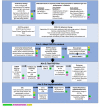A Multicomponent Intervention to Train and Support Family Medicine Providers to Promote Pre-exposure Prophylaxis (PrEP) for Adolescent Girls and Young Women in the Deep South: Protocol for the PrEP-Pro Study
- PMID: 36943364
- PMCID: PMC10131664
- DOI: 10.2196/44908
A Multicomponent Intervention to Train and Support Family Medicine Providers to Promote Pre-exposure Prophylaxis (PrEP) for Adolescent Girls and Young Women in the Deep South: Protocol for the PrEP-Pro Study
Abstract
Background: Pre-exposure prophylaxis (PrEP) is a highly effective biomedical prevention intervention and a major strategy for reducing the HIV burden in the United States. However, PrEP provision and uptake remain lower than estimated needs, and in ways that may exacerbate HIV disparities among Black adolescent girls and young women in the southern United States. Data suggest that gaps in provider knowledge of HIV epidemiology and PrEP and skills assessing sexual health practices are important barriers to provision and uptake, with limited evidence-based interventions to address these gaps.
Objective: This paper describes the "PrEP-Pro" intervention, a multicomponent intervention to train and support family medicine (FM) trainees to promote PrEP for adolescent girls and young women in Alabama.
Methods: The PrEP-Pro intervention comprises 3 main components guided by the Capability-Opportunity-Motivation-Behavior (COM-B) model for behavioral change and the Consolidated Framework for Implementation Research (CFIR): (1) provider HIV epidemiology and PrEP education, (2) sexual history taking, and (3) PrEP Champions. In phase 1, we will work with community advisory boards (providers and clients) and then conduct focus groups with FM trainees to adapt content to train FM residents on HIV epidemiology and PrEP and develop implementation strategies, including provider-facing tools and client-facing educational materials. In phase 2, we will pretest and then pilot-test the initially adapted PrEP-Pro intervention with FM trainees. FM trainees will complete baseline, 3-, and 6-month questionnaires post PrEP-Pro intervention. We will also conduct in-depth interviews (IDIs) with FM pilot participants, adolescent girls and young women who accessed care after the PrEP-Pro pilot, and key stakeholders. The primary outcomes are PrEP-Pro acceptability and feasibility, which would be assessed using validated instruments at months 3 (among pretest participants) and 6 (among pilot participants). Secondary outcomes will also be assessed, including PrEP knowledge, sexual history-taking attitudes and practices, PrEP prescriptions among adolescent girls and young women encounters, and sexually transmitted infections (STIs) and HIV testing among adolescent girls and young women encounters in 6 months.
Results: Study results will be disseminated to practices, state health officials, and other key stakeholders to solicit feedback on implementation opportunities and challenges to inform a hybrid effectiveness implementation trial. Our results will also be presented at local and national conferences and submitted to peer-reviewed journals.
Conclusions: As PrEP grows, there is a pressing need to train FM providers and develop appropriate, contextually relevant tools to support PrEP implementation. The PrEP-Pro intervention is a multicomponent intervention to train FM residents across Alabama on sexual history-taking, PrEP provision for adolescent girls and young women, and supporting practice-based PrEP Champions. The PrEP-Pro intervention is anticipated to increase PrEP prescriptions for adolescent girls and young women and expand comprehensive sexual and reproductive health care for adolescent girls and young women in rural and urban Alabama.
International registered report identifier (irrid): PRR1-10.2196/44908.
Keywords: HIV; PrEP Pro intervention; adolescent girls and young women (AGYW); community; family medicine; family medicine trainees; pre-exposure prophylaxis (PrEP); prevention; reproductive health; sexual health; teens; training; young women.
©Oluwaseyi O Isehunwa, Samantha V Hill, Alex Tobias Menninger, Brook Hubner, Douglas Krakower, Dustin M Long, Madeline C Pratt, Meredith E Clement, Nicholas Van Wagoner, Robin Gaines Lanzi, Tina Simpson, Latesha Elopre, Lynn T Matthews. Originally published in JMIR Research Protocols (https://www.researchprotocols.org), 21.03.2023.
Conflict of interest statement
Conflicts of Interest: MEC has received research support (grants to the institution) from Gilead Sciences and Viiv Healthcare, has served on advisory boards for Roche Diagnostics Corporation and Viiv Healthcare, and has received personal fees for educational events from Vindico Medical Education, Practice Point Communications, and Prime Education. LTM has received research support (grants to the institution) from Gilead Sciences.
Figures


References
-
- HIV in the United States and dependent areas. Centre for Disease Control and Prevention. [2023-02-14]. https://www.cdc.gov/hiv/statistics/overview/ataglance.html .
-
- HIV and women: HIV diagnoses. Centre for Disease Control and Prevention. [2022-09-06]. https://www.cdc.gov/hiv/group/gender/women/diagnoses.html .
-
- HIV surveillance report, 2017. Centre for Disease Control and Prevention. 2018. [2023-02-14]. https://www.cdc.gov/hiv/pdf/library/reports/surveillance/cdc-hiv-surveil... .
-
- HIV in the Southern United States. Centre for Disease Control and Prevention. 2019. [2022-09-06]. https://www.cdc.gov/hiv/pdf/policies/cdc-hiv-in-the-south-issue-brief.pdf .
Grants and funding
LinkOut - more resources
Full Text Sources
Medical
Research Materials
Miscellaneous

